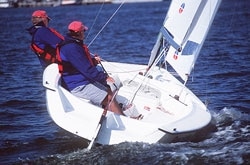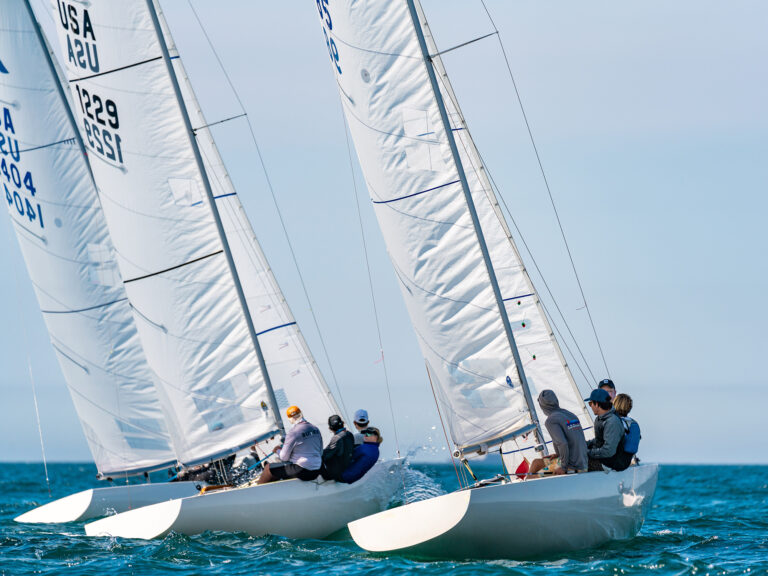
The Precision 185 was voted Best Value for its combination of good sailing characteristics, substantial construction, and reasonable cost. First and foremost this boat performs well; yet it shouldnt intimidate even entry-level sailors. The Precision 185 also appears well built, and at $7,495 is a tremendous value for an 18-foot daysailer.
We test sailed the Precision in the Severn River off the Naval Academy following the U.S. Sailboat Show in light air, averaging about 6 knots with puffs to around 10 and lulls down around 4. With two aboard, the boat went well both upwind and down. Tacking angles were better than average for an introductory-level daysailer, much closer-winded than many shoal-draft cruiser/racers, but as expected, seemed just a shade wider than the highest performance dinghies. We could roll tack the Precision, but still the boat was stable enough that we never felt on edge as many narrower waterline dinghies feel. In the puffy conditions this Jim Taylor design accelerated quickly and responded well to moving crewweight from leeward side to weather and back again. In each position–to leeward, crouched over the board trunk, on the weather seats, or hiking–there was a comfortable place to sit and the path across presented fewer obstacles than many dinghies. As racers, the judges had the instinct to sit on the wide rail and hike out in the gusts. This would have been difficult in breezier conditions without hiking straps but that could easily be rectified.
Downwind it was easy to go wing and wing, heeled to weather with the helmsman holding the jib out. This boat is so stable that the crew was also to weather instead of the usual centerline position on the board trunk, even with the centerboard mostly raised. For daysailing or one-design racing, downwind speed was fine but a spinnaker or gennaker would have certainly improved performance. As judge Meade Gougeon noted, “I envision this hull having great surfing potential that could get unlocked with the right spinnaker package.”
We simulated a dinghy race starting line, stopping with sails luffing and then sheeting in just above the leeward pin. The Precision 185 held position well and then accelerated smoothly off the line when we sheeted in. In addition to performance sailing, the Precision 185 is targeted towards daysailing whether singlehanding or with four or more aboard. Its ballasted board and the fact you can roller furl the jib and sail on main alone expand the range for comfortable singlehanding. Testing the other end of the spectrum, the whole judging panel came aboard, including BOTY Director Peter dAnjou, for a total of four skeptical speed merchants. All of us were pleasantly surprised that the Precision still moved well, had plenty of seating and, ever mindful of speed, didnt excessively drag its transom.
Precision and Jim Taylor have been in the trailerable boat market for almost 20 years and their experience shows in the 185. Its clear this boat was designed to sail in shallow waters with the kick-up rudder and centerboard. The board relies on steel ballast to hold it down, but will automatically pivot up in an accidental grounding. The kick-up rudder has a line that holds it down, led to a pressure release Clamcleat on the underside of the tiller. This arrangement is also well-suited to ramp launching or finding a nice beach for lunch between races.
Also notable on this Precision are a spray rail protecting the cockpit, a 36-quart cooler located between the mast and centerboard trunk, and a swim step separated from the cockpit by enough of a coaming that moderate chop wont come aboard. Theres also a storage locker under the foredeck.
Hardware is simple and primarily by Harken, with 2-to-1 purchase jib sheets to swiveling jam cleats on athwartships, adjustable jib tracks, jib furling, 4-to-1 mainsheet with ratchet block and jam cleat, 4-to-1 boom vang and 3-to-1 tackle to raise the ballasted centerboard. All control lines were easy to reach and easily adjusted, and our only suggestion was to move the furling-line jam cleat farther forward so it would be difficult to sit on when hiking out. The mast bend and mainsail were well matched so that the sail flattened when sheeted on in the puffs and powered up when the sheet was eased in the lulls. Jib luff tension is set when raising the deck-stepped mast and is controlled by the aft-swept shrouds and Ronstan shroud adjusters with the forestay removed and then pulling the rig forward and pinning the forestay furling drum in place. On-the-water adjustment systems are great, but the increased cost would tend away from the Best Value exhibited in the Precision.
While some builders are producing dinghies with roto-molded or thermoformed plastic, Precision Boatworks builds their line, including the 185, in what has become the tradition of hand-laminated fiberglass. Outside skins are vinylester for blister resistance and improved moisture barrier. E-glass reinforcements in polyester resin make up the balance of the laminate with Klegecell closed-cell PVC foam coring in deck panels and where hull stiffening is required. The resulting hull and deck laminates were appropriately stiff with no noticeable oil canning when slamming into powerboat wakes and a firm feel to the deck and cockpit. The 185 is built from two moldings, hull and deck, that are joined with an overlap joint, but with the added detail of a plastic rub rail that will surely diminish the dock-ding damage that has caused leaks in so many similarly joined boats. Inspection ports provide access to rudder gudgeons and the forward storage area under the mast. Here the deck-stepped mast is supported by a substantial under-deck fiberglass box-beam that allows the locker cutout to be located immediately below.
This combination of substantial construction, moderate price, and good sailing performance earn the Precision 185 the Best Value title for the year. Additions of spinnaker and hiking straps wont break the budget, but will add further to the value for performance-minded sailors.
www.precisionboatworks.com









